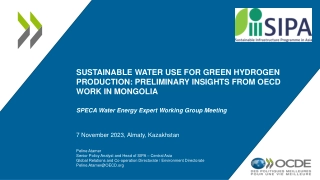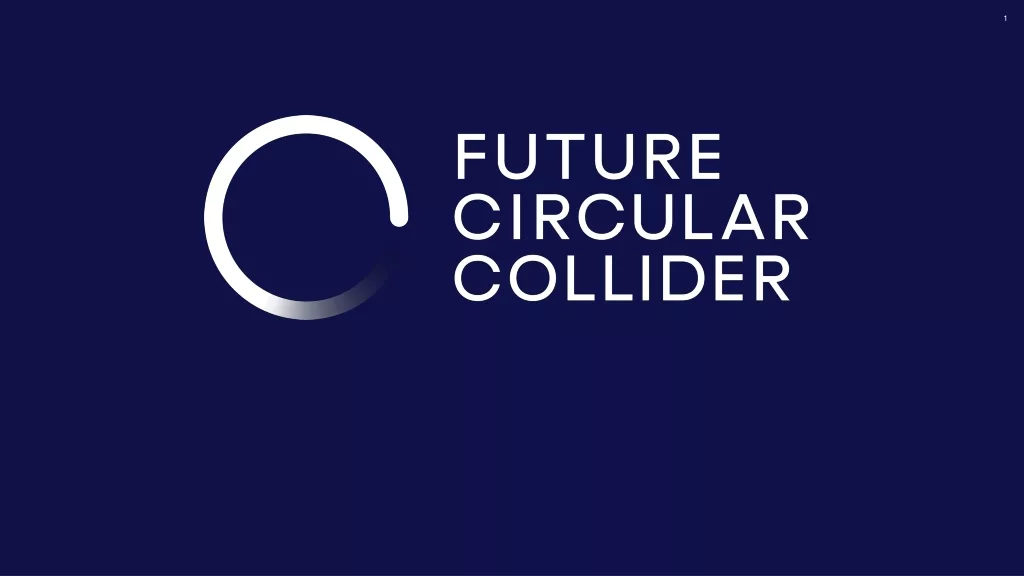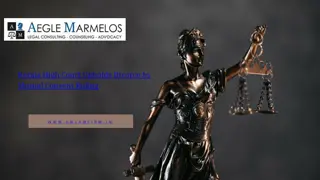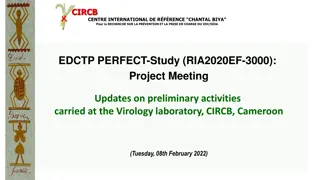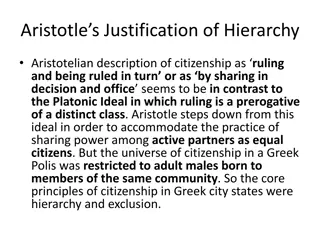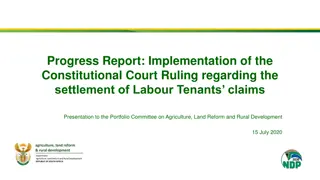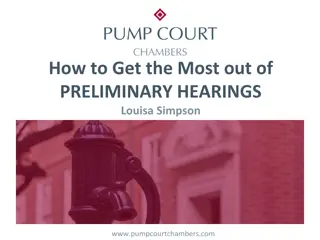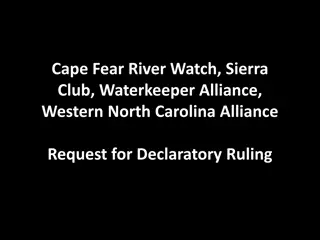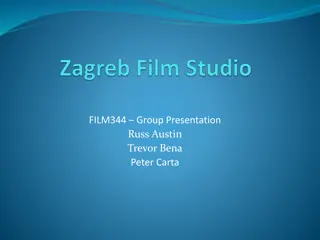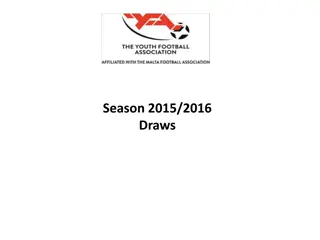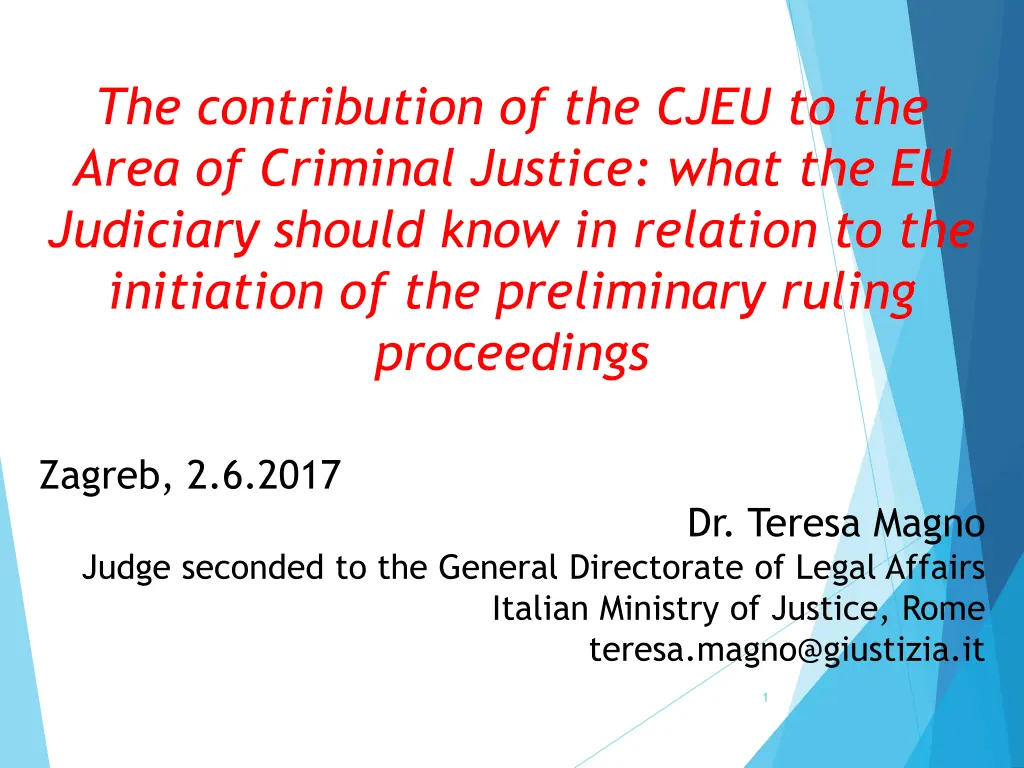
EU Judiciary's Insights on CJEU's Role in Criminal Justice
Explore the significant contributions of the CJEU to the area of criminal justice, focusing on the initiation of preliminary ruling proceedings and the structure of the presentation. Gain insights into the key features of CJEU's preliminary ruling procedure, including referrals, orders in practice, accelerated procedures, and urgent procedures. Delve into the main cases brought to the CJEU in 2016, the countries with the most requests for preliminary rulings, and the completion status of cases in the same year.
Download Presentation

Please find below an Image/Link to download the presentation.
The content on the website is provided AS IS for your information and personal use only. It may not be sold, licensed, or shared on other websites without obtaining consent from the author. If you encounter any issues during the download, it is possible that the publisher has removed the file from their server.
You are allowed to download the files provided on this website for personal or commercial use, subject to the condition that they are used lawfully. All files are the property of their respective owners.
The content on the website is provided AS IS for your information and personal use only. It may not be sold, licensed, or shared on other websites without obtaining consent from the author.
E N D
Presentation Transcript
The contribution of the CJEU to the Area of Criminal Justice: what the EU Judiciary should know in relation to the initiation of the preliminary ruling proceedings Zagreb, 2.6.2017 Dr. Teresa Magno Judge seconded to the General Directorate of Legal Affairs Italian Ministry of Justice, Rome teresa.magno@giustizia.it 1
Structure of the presentation Features of CJUE Preliminary ruling procedure: -Referral (purpose, option/obligation to refer and evaluation of the need for a preliminary ruling request) -Order in practice (structure, layout and content) Accelerated procedure Urgent procedure Key CJEU judgements 2
Cases brought to CJUE in 2016 (Source: 2016 CJUE Annual report) 692 cases brought 453 Preliminary including 8 PPU 35 Direct actions 175 Appeals against decisions of the General Court 7 Application for legal aid ruling proceedings 3
Preliminary ruling proceedings: 2016 figures (Source: 2016 CJUE Annual report) Main Member States from which the requests originated in 2016 Germany: 84 Italy: 72 Spain: 47 Netherlands: 26 Belgium: 26 4
Cases completed in 2016 (Source: 2016 CJUE Annual report) 704 cases completed: 453 Preliminary ruling proceedings including 9 PPU 49 Direct actions (including 27 failures to fulfil obligations found against 16 Member States) 189 Appeals against decisions of the General Court (in 21 of which the decision adopted by the General Court was set aside) 5
Preliminary ruling procedure Reference for a preliminary ruling is a fundamental mechanism of EU law aimed at enabling the courts and tribunals of the MSs to ensure uniform interpretation and application of that law within the European Union CJ has contributed to the building up of the former EC and actual EU legal order through the preliminary ruling procedure Most protection of the individual rights vis- -vis EU and MS institutions effective and widely used instrument for the 6
Courts jurisdiction (1) CJEU has jurisdiction to give preliminary rulings on the interpretation of Union law and on the validity of acts adopted by the institutions, bodies, offices or agencies of the Union (Article 19(3)(b) TEU and Article 267 TFEU) GC is to have jurisdiction to hear and determine questions referred for a preliminary ruling under Article 267 TFEU in specific areas laid down by the Statute (CJUE alone currently preliminary rulings since no provisions have been introduced into the Statute laying down the areas referred to in Article 256(3) TFUE) has jurisdiction to give 7
Courts jurisdiction (2) Primary law provisions lay down exceptions to the general jurisdiction of CJUE under Article 267 TFEU Article 276 TFEU: the Court has no jurisdiction to review the validity or proportionality of operations carried out by the police or other law enforcements services of the MSs or responsibilities incumbent upon Member States with regard to the maintenance of law and order and the safeguarding of internal security the exercise of the 8
Jurisdictions eligible to refer questions Court or Tribunal (Art.267 TFUE): bodies that satisfy the concept of holding jurisdiction in MSs General concept of jurisdiction for the purpose of EU law Bodies have to satisfy the following requirements: 1. they are established by law 2. they exercise judicial functions permanently or more than just occasionally 3. their jurisdiction is compulsory 4. their procedure is inter-partes 5. they apply rules of law 6. they are independent and impartial 9
Option or obligation to refer? The national Court or Tribunal may request the Court to give a ruling if a judicial remedy is available under national law against the judgements they deliver (margin of discretion) The national Court or Tribunal must request the Court to give a ruling if a judicial remedy is not available under national law against the judgements they deliver What if in practice no Court is obliged to lodge a preliminary reference? 10
When referral is necessary? It is up to the national courts (both the lower and the highest courts) to determine the relevance of the questions referred The question regarding the interpretation of EU law has to be relevant = the answer affects the outcome of the case The interpretative problem is concrete (hypothetical questions are dismissed) N.B. No advisory opinions can be sought v. Protocol no.16 to the ECHR, when in force 11
Purpose of reference CJEU provides the domestic courts with all the elements of interpretation of EU law necessary to assess the compatibility of EU law with national law CJEU can redefine the referred questions so as to give a more helpful answer to the referring court Domestic courts rule on the compatibility and determine the case (In practice CJUE s judgments and orders may determine the case) CJEU s judgements are binding National courts have a duty to apply the Court s ruling to the facts before them Art.267 TFUE envisages a system of cooperation between the CJEU and national courts to ensure that EU law is interpreted uniformly across the MSs 12
Exceptions to the obligation to refer (1) EU law does not come into play in the case Settled case-law, independently of the nature of the proceedings in which the question has arisen (theory of acte clair ) Correct application of EU law is so clear and obvious that there is no scope for any reasonable doubt regarding the solution to be given to the question raised (theory of acte claire; in claris non fit interpretatio) 13
Exceptions to the obligation to refer (2) CILFIT criteria for acte claire provide useful guidance. - The matter must be equally obvious to all national courts (takin into account that EU law is drafted in several languages and uses terminology that is peculiar to it) - Legal concepts do not necessarily have the same meaning in EU law and the law of the various MSs - EU law must be placed in context CILFIT criteria for acte claire demand a significant level of language expertise and detailed legislation knowledge of EU 14
Violation of Article 6 1 of the ECHR if no reasons on refusal to refer are provided CASE OF VERGAUWEN and Others v. BELGIUM CASE OF DHAHBI v. ITALY CASE OF WIND TELECOMUNICAZIONI SPA v. ITALY 15
The order for reference: practical information The order for reference is to be sent by the national court directly to the CJEU by registered post (address: Registry of the Court of Justice, Rue du Fort Niedergr newald, L-2925 Luxembourg). Exception: expedited procedure and urgent procedure (email or fax + post) (mail:ECJ-Registry@curia.Europa.eu; fax +352433766) Notice of the request for a preliminary ruling is given in the Official Journal of the European Union National courts are requested to send the whole of the case-file so that the Court may be better placed to give a useful answer 16
The order for reference The domestic decision may be in any form allowed by national law as regards the procedural phase order must sufficiently complete and contain all the relevant information to provide the Court and the parties with clear understanding of the factual and legal context of the main proceedings The be succinct but 17
Content of the order (1) The order MUST include: Summary of the subject matter of the dispute and the relevant findings of fact The tenor of national provisions applicable in the case and, where appropriate, the relevant national case-law A statement of the reasons that prompted the referring court to inquire about the interpretation of certain provisions of EU law A statement of the relationship between the relevant provisions of EU law and the national legislation applicable to the main proceedings N.B. In the absence of one or more of the above, the Court may have to decline jurisdiction or dismiss the request as inadmissible 18
Content of the order (2) The order MUST also include: Reasons for specific treatment (anonimity and rapidity) Identification of the relevant to the case The order SHOULD include, if need be, a brief summary of the relevant arguments of the parties to the main proceedings The referring court MAY include: A brief statement on the answer to be given to the question referred - EU law provisions - - 19
What to check when evaluating the need for a preliminary ruling request? (1) A. CJEU has jurisdiction ratione materiae? (Is EU applicable?) 1.Treaty provisions 2.Secondary legislation (regulations, directives, decisions) 3.Charter of fundamental rights of the EU (Art.51 CDFUE, cfr. C- 617/10 AKERBERG FRANSSON, C-399/11 MELLONI; see p.10 of 2016 Recommendations) (N.B. Provisions of the Charter are addressed to MSs only when they are applying EU law see Recommendations 2016) B. CJEU has jurisdiction ratione temporis? Check the time of accession to the EU of the MS (C-153/13 Pohotovost: the Court has jurisdiction to interpret EU law only as regards its application in a Member State from the date of that State s accession to the European Union) C. proceedings Assess the relevance of the interpretation of EU for the main 20
What to check when evaluating the need for a preliminary ruling request? (2) Does CGUE s case-law exist in the matter? Is the interpretation of the relevant EU provisions obvious? Is it the appropriate stage? (factual and legal contexts are clear enough?) What are the reasons for requesting the interpretation of EU law and what is the relation between EU law and national law? N.B. It may desirable for the reference to be made only after both sides have been heard 21
Layout of the request The order should be structured in points or paragraphs and have clear headings Different points or paragraphs of the order should be numbered (in order to make it easier to read and refer to the document) The question/s should be written in a separate and clearly identified section of the order for reference, at the beginning or at the end Remember: it has to be possible to understand the question/s without referring to the statement of the grounds for reference 22
Formal aspects of the request The request should be typed on white, unlined, A4-size paper The request should be in a commonly used font (such as Times New Roman, Courier or Arial), in at least 12 point in the body of the text and at least 10 point in any footnotes, with 1,5 line spacing and horizontal and vertical margins of at least 2,5 cm (above, below, at the left and at the right of the page), and All the pages of the request, and the paragraphs they contain, should be numbered consecutively. 23
Language and length of the request The request for a preliminary ruling should be drafted simply, clearly and precisely, detail, keeping in mind the need to translate the order into all the official languages of the European Union avoiding superfluous About 10 pages should be sufficient to set out in a proper manner the context of the request (see: issues related to possible summary of longer requests, their translation and services) 24
Template for a reference request 1.Questions 2.Subject matter of the dispute (summary) 3.Relevant findings of fact by the national court (or account of the facts on which the questions referred are based) 4.National law provisions and relevant national case law principles (summary) 5.European law provisions 6.Summary of the relevant arguments of the parties 7.Statement of reasons for the request (grounds for each questions) 8.Statement of the domestic court s view on the correct answer (optional) 25
Anonymity (Art.95 of the Rule of Procedure of the CJUE) The CJUE respects the decision of the referring judge to grant anonymity The CJUE may grant anonymity at the request of: -the referring judge -a party to the main proceedings (a duly reasoned request has to be submitted) The CJUE may grant anonymity of its own motion A notice related to the case concerned is published in the OJ and the request is served to the interested parties. Thus, any anonymization after publication and service is devoid of practical purpose 26
Notification of the request (1) Immediate translation of the order Notification of the order by the Registrar to the parties of the main proceedings, the Member States and the Commission Notification of the order by the Registrar to the institution, body, office or agency of the Union which adopted the act the validity or interpretation of which is in dispute 27
Notification of the request (2) Notice is given to: 1. the lawyers of the main proceedings 2. the parties (to their personal address as set out in the order) if they are not represented 3. the MSs addressed to the Ministry of Foreign Affaires (with a copy to the Permanent Representation in Brussels) 4. the States parties to the EEA Agreement and to the EFTA Surveillance Authority, if need be 28
The written part of the procedure (1) Statements of case or written observations to be submitted within 2 months of the notification of the order for reference, including the extension of 10 days for distance (the 2 months period is calculated according to common procedural rules on time limits i.e. notification 2.06.17, period runs from 3.06.17 at 0 hours to 2.8.17 at 24 hours) served on 29
The written part of the procedure (2) Observations are sent to all those to whom the order notified second exchange observations for reference was No of written No intervention of natural or legal person is allowed Only the parties of the main proceedings are allowed to procedure participate in the 30
The oral part of the procedure Non-participation in the written part of the procedure does participation in the oral part of the procedure opportunity counter-arguments ( debate before the Court) not preclude Full for arguments be and to presented Reopening of the oral part ex officio is possible 31
Optional character of the hearing A reasoned request for a hearing must be submitted within a period of 3 weeks after (service of) the notification of the close of the written part of the procedure Rarely a hearing is organized without a request On the proposal of the Judge Rapporteur and after hearing the Advocate General, the Court may decide not to hold a hearing (sufficient information provided by the written observations) Where a question referred to the Court is identical to a question on which the Court has already ruled, where the reply to such a question may be clearly deduced from existing case-law or where the answer to the question referred admits of no reasonable doubt, the Court may at any time, on a proposal from the Judge Rapporteur and after hearing the Advocate General, decide to rule by reasoned order (Art.99 RP CJEU) 32
The expedited procedure (1) Existence of exceptional urgency (the nature of the case requires that a ruling is delivered in a short time) Importance to the Union of the area of law in which the order for reference has been made (i.e. fight against terrorism) Application on the procedure rejected when asked on the grounds of: 1. the large number of persons or legal situations concerned; 2. serious damaging effects; 3. the sensitive economic or social nature of the case; 4. the length of criminal proceedings before a national court. Recourse to this procedure might be justified if the referring judge is required to decide the case pending before it within a specific time limit 33
The expedited procedure (2) The procedure is applied at the request of the national court or exceptionally by the CJEU of its own motion Application has been rejected in case of very few or no elements substantiating the request (poorly drafted request) and in case of lack of assessment on the exceptional urgency judge by the referring Shorter terms are given to the parties and to the Court itself 34
The urgent preliminary ruling procedure: the scope PPU exists for questions in the areas covered by Title V of Part Three of TFUE It is applied at request of the referring judge or exceptionally ex officio (C-491/10 PPU Aguirre Zarraga) The urgency and the justification of the application of the procedure have to be explained on the basis of the factual elements and legal issues of the case definition of urgency Recommendations) of the answer proposes to the issue of urgency and the questions referred No (ref. p.33 of 2016 Consideration the referring judge 35
The preliminary ruling procedure: written part The procedure of the designated Chamber is served on the referring judge, on the MS from which the reference is made and on the parties decision of application or rejection of the Content of the decision include: 1.time-limit to submit written observations; 2.matters of law to which the written observations must relate; 3.maximum length of the observations. 36
Procedural aspects of the PPU Importance of the oral part Omission of the written part of the procedure is allowed for in case of extreme urgency Preliminary report submission to the general meeting of the Court is drawn up quicklier by the Judge Rapporteur for the 37
Measures of organization of procedure Parties may be invited to answer certain questions in writing or at the hearing Parties are invited at the hearing to concentrate their oral pleadings on one or more specific issues The Judge Rapporteur or the Advocate General may send questions to be hearing to the parties at answered the 38
Withdrawal of the order A reference may be withdrawn in case of amicable settlement A reference may be withdrawn if the national proceedings were discontinued The Court may declare that the conditions of its jurisdiction are no longer fulfilled The Court remains seized of the request only if an actual dispute is pending before the referring judge (exception Art.100 of Rules of Procedure) 39
Consequences of not fulfilling the requirements Strict interpretation of conditions (possible exceptions) (in 2016 out of 12 requests for PPU to be applied, 4 were rejected) Request of clarification Order stating inadmissibility 40
Costs and legal aid The costs of the preliminary ruling proceedings are for the referring judge to decide Parties to the main proceedings unable to meet the costs of the proceedings before the CJUE may at any time apply for legal aid The decision on the application for legal aid is taken by the smallest formation to which the Judge Rapporteur in the case has been assigned The application for legal aid can be granted in whole or in part The order refusing the application for legal aid has to be reasoned 41
Language of the case The language of the case is the language of the referring judge. Written observation have to be drawn up and the parties have to plead in that language Derogations: proceedings may use their official language; one of the parties to the main proceedings may be authorised to use another official language of the EU (duly substantiated submitted) MSs when taking part to the request has to be 42
Interpretation of preliminary rulings No preliminary rule can be made request for interpretation of a In case of doubts on the meaning or scope of the preliminary ruling, new reference Referring judge assesses that sufficient guidance has been given by a preliminary ruling or a further reference to the Court is required 43
Judgements on Interpretation and Translation C-278/16 Frank Sleutjes (AG s opinion delivered on 11.5.17; penalty order- is an essential document and must be translated if addressee does not understand German) Strafbefehl- C-25/15 Istv n Balogh C-216/14 Gavril Covaci 44
Handbook on European law relating to access to justice European Union Agency for Fundamental Rights and Council of Europe completed the handbook in January 2016 Practical guide for judges, practitioners involved in litigation in the EU and in Council of Europe MSs The handbook summarizes principles in the area of access to justice The relevant provisions of the Council of Europe and the European Union are presented as they apply to each topic (i.e. legal aid, right to represented, right to an effective remedy, fair and public hearing before an independent and impartial tribunal or other bodies) http://fra.europa.eu/sites/default/files/fra_uploads/fra- ecthr-2016-handbook-on-access-to-justice_en.pdf prosecutors and legal the key European legal be advised, defended and 45
FRA Report on rights to interpretation, translation and information issued in November 2016 Comparative report on rights to interpretation and translation in criminal information in criminal proceedings proceedings and right to Guidance on how the rights of suspects and accused persons can be improved in line with the two directives Conclusions: both national laws and their application could be improved of good practices applicability of the rights Series to help improve the fra.europa.eu/en/country-data/2016/country-studies- project-right-interpretation-and-translation-and-right- information 46
Thanks for your kind attention 47

